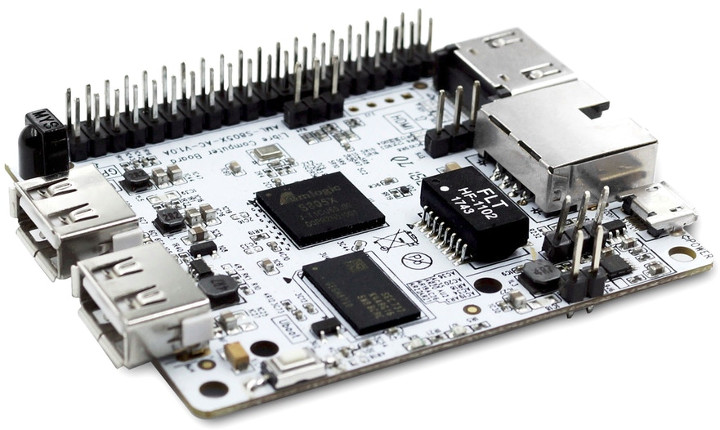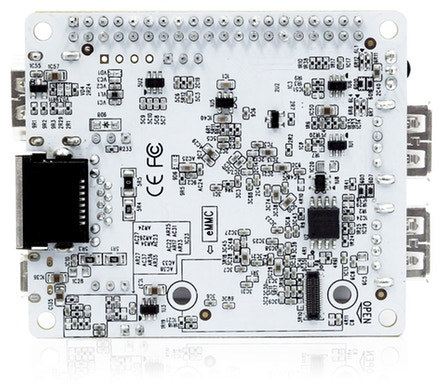Libre Computer first started with their AML-S905X-CC (aka Le Potato) board powered by Amlogic S905X processor last year, and they’ve since then launched several other boards based on Allwinner or Rockchip processor.
But their latest “La Frite” board – also known as AML-S805X-AC – is an even lower cost version of the “Le Potato” board, with an Amlogic S805X processor limited to 1080p60 output and video decoding, a smaller footprint based on the one for Raspberry Pi Model A+, and price starting at just $5 on Kickstarter.
 AML-S805X-AC “La Frite” board specifications:
AML-S805X-AC “La Frite” board specifications:
- SoC – Amlogic S805X quad core ARM Cortex-A53 processor @ 1.2 GHz with penta core ARM Mali-450MP GPU @ 650 MHz, and Amlogic Video Engine 10
- System Memory – 512 MB or 1GB DDR4 @ 2400 MHz
- Storage – eMMC module connector, 128 Mb SPI NOR flash
- Video & Audio Output – HDMI 2.0 port
- Video Codecs
- Decoding – Up to 1080p60 VP9 P2, 10-bit H.265, and H.264. MJPEG is also supported.
- Encoding – H.264 up to 1080p30
- Connectivity – 10/100M Ethernet (Low profile)
- USB – 2x USB 2.0 host ports
- Expansion – 40-pin Raspberry Pi A+ header with I2C, SPI, PWM, 5V, 3.3V, and GPIOs
- Debugging – 3-pin UART header for the serial console
- Misc – IR Receiver, U-boot button
- Power Supply – 5V via micro USB port
- Dimensions – Raspberry Pi A+ form factor
 The board does away with a micro SD card slot, so the only boot options will be over the network or USB drive using the SPI flash to store the bootloader, or via an optional eMMC module. Some will call it “courage”, while other may cry foul…
The board does away with a micro SD card slot, so the only boot options will be over the network or USB drive using the SPI flash to store the bootloader, or via an optional eMMC module. Some will call it “courage”, while other may cry foul…
The board is said to run Ubuntu, Debian, LibreELEC, Lakka, RetroPie, Android 8.0 Oreo, and many more Linux-based distributions. Normally, when you see a long list of supported OS, it should raise your eye brows as it often means poor support for each image. However, Libre Computer has been the company sponsoring most of the work to support S905X in mainline Linux, and they’ll do the same for S805X. As such all their boards will be running operating systems based on mainline Linux (except for Android I assume…). They also plan to provide a unified ARM64 image for all their Amlogic, Allwinner, and Rockchip boards. Le Potato and La Frite boards will also soon be able to play H.265, H.264, and VP9 content on upstream Linux with Chromium, which as far as I know has not been done before.
The $5 price tag mentioned in the introduction is for a “La Frite” board with 512MB, while the 1GB RAM board goes for $10, but those are KickStarter “early bird” specials, and eventually the normal price should be around $20 for the 512MB RAM version, and $30 with 1GB RAM on shops like Amazon. Shipping adds $7 to the US, and $9 to the rest of the world, and you won’t have to wait for long for the rewards as shipping is scheduled for next month.

Jean-Luc started CNX Software in 2010 as a part-time endeavor, before quitting his job as a software engineering manager, and starting to write daily news, and reviews full time later in 2011.
Support CNX Software! Donate via cryptocurrencies, become a Patron on Patreon, or purchase goods on Amazon or Aliexpress




